Wheat Disease Update Archives
Helpful Resource for Rust Diseases: Identifying Rust Diseases in Wheat and Barley
K-State Foliar Fungicide Efficacy Ratings
K-State Wheat Variety Disease and Insect Ratings
Hello There!
I checked wheat yesterday and began finding stripe rust and scattered leaf rust pustules in Sherman, Thomas and Cheyenne Counties. This is in addition to finding both stripe and leaf rust in Wallace County on Monday. I am finding the rust on 1 and 2 leaves below the flag leaf (FL-1 and FL-2). Even though I can find both of these fungal diseases, I am spending quite a bit of time looking in the most susceptible varieties. And the pustules are just emerging from the leaf surface in the susceptible varieties. I have not found rust in the more resistant varieties, but I haven’t spent quite a much time scouting in those varieties. In addition, since the pustules are just emerging, there is very little orange is wiping off the leaf onto your thumb or finger. Therefore, it is important to look for a rust pustule ‘bump’ on the leaf. To see this roll the leaf over your finger against the light to see if there is a bump on the leaf surface.
I put together this graphic shows the progression of stripe rust (and some of the different stages that you are seeing in the field):
So, now is the time for making fungicide decisions in far northwest Kansas. I would prioritize the fields with the most susceptible varieties. Those include Avery, Byrd, Brawl CL, and Denali. These are rated 7 and 8 (on the 1 – 9 scale with 1=resistant and 9=susceptible). Look up your variety rating with the K-State Wheat Disease and Insect Ratings publication: https://www.bookstore.ksre.ksu.edu/pubs/MF991.pdf
Many fungicides provide very good to excellent control of both the stripe rust and leaf rust. Here is the publication outlining the efficacy of many fungicides for several wheat diseases (including stripe rust and leaf rust): https://www.bookstore.ksre.ksu.edu/pubs/EP130.pdf
With the weather forecast, it is going to be difficult to get into the field to apply your own fungicide. However, you if you are able to get into the field between rain showers, be sure to check the rainfast period for the product you are applying. For many of the generic tebuconazol products, the label says it must have 2-4 hours of drying time before rain or irrigation. It is different for other fungicides, so be sure to check the label of the product you are applying.
Here is a 7 minute video that I recorded in the field last night discussing the stripe rust and leaf rust (and where to look on the plant when you are scouting wheat): https://www.facebook.com/kstatesunflowerdistrict.agronomy/videos/430871794410295/
If you have any questions on what I am finding in the field, please let me know. Thank you to everyone who has been scouting for wheat rusts and letting me know what they are finding! I really appreciate the group effort in scouting!
Jeanne
Hello There!
I looked at wheat yesterday and found stripe rust in Wallace County. It was in a susceptible variety, Avery. Avery is rated an 8, on a 1 to 9 scale with 1=highly resistant and 9=highly susceptible. It was located on the leaf below the flag leaf (FL-1) and was very challenging to find.
I also did a quick look at the wheat plot in Cheyenne Co on Sunday evening, but didn’t find stripe rust there. Before finding stripe rust in southern Wallace County, the closest stripe rust report to us was from last Friday when stripe rust was found low in the canopy south of Oakley in the Byrd variety.
For stripe rust, the timeline from the point of infection to rust pustules is 2-3 weeks. Therefore, I think the infection timing corresponds to the damp and foggy weather that we had on May 6. During that week, we had over a 140 hours across Cheyenne, Sherman and Wallace Counties that was favorable to the development of rust diseases (over 85% relative humidity).
If you would like to check the susceptibility of your variety, here is the publication with stripe rust ratings: https://www.bookstore.ksre.ksu.edu/pubs/MF991.pdf. It is also attached to this email. An easy chart to look up several varieties is located in the back of the publication on pages 18-19. Some of the most susceptible varieties planted in our area are: Byrd, Brawl CL, Denali, Avery, TAM 112 (rated 7 and 8). Varieties planted in our area, that are showing more rust than in the past include: SY Monument (was rated a 2), WB Grainfield (was rated a 6), LCS Chrome (was rated a 3).
In general as we are thinking about fungicide applications, the time to begin spraying is when stripe rust is located right below the flag leaf and the flag leaf is completely emerged (like what I found in Wallace Co on the first leaf below the flag leaf). Fungicides move fairly well in the leaf, but do not move easily from leaf to leaf on the plant. That is why the flag leaf being emerged is very important. Also, we want to have the fungicide applied early enough to protect the flag leaf.
It is also important to keep in mind the preharvest interval for each product. Here is a chart that lists the harvest restriction for many products: https://www.plantpath.k-state.edu/extension/publications/EP130.pdf. I have attached it also to this email. The harvest restriction can vary from 45 days to the growth stage 10.5 (wheat fully headed and flowering has not started). It is important to check the label for the product that you are using.
Fungicide provides between 18 and 21 days of control for fungal disease. In addition, many products do a very good job controlling stripe rust and leaf rust. The chart with the harvest restrictions also contain efficacy ratings for several fungicides. All are rated very good to excellent for control of stripe rust and leaf rust. In addition, I had a bit of research on stripe rust control with several different fungicides a few years ago. Here is a summary chart for fungicide efficacy.
Finally, I am going to keep checking wheat for both leaf and stripe rust. Today would not be much fun for looking for rust, but would be a great day to be a fungal disease! I will continue to let you know what I am finding in the field. If you have any questions, please let me know!
Hello There!
Its time again for an update on the status of rusts in wheat. The good news is that I have not found rust (leaf or stripe rust) in the wheat plots in Cheyenne, Sherman, or Wallace Counties or in farmers’ fields that I have scouted. I looked at three of the four variety plots in the last two days and found no rust. In the wheat plots, I generally target and spend the most time in the varieties that are known to be susceptible. These varieties include Byrd, Avery and Denali.
Generally, I refer you to look up the levels of susceptibility or resistance for your wheat varieties, in our wheat disease ratings publication. However, this year it there seems to be a bit of a shift in the stripe rust susceptibility. According to K-State wheat pathologist Erick DeWolf, there are indications that genetic resistance of some important wheat varieties is not as effective this season. Preliminary reports indicate the SY Monument, Larry, LCS Chrome and AG Icon varieties are all showing signs of greater susceptibility this year. WB Grainfield, which had an intermediate reaction to stripe rust last year, also appears to developing more disease than expected this year.
In addition, flag leaves are emerging. In a few of the most advanced fields, you can find beards poking out of the boot or heads beginning to emerge. So, now is the time we would talk about applying a fungicide for stripe or leaf rust. However, since we are not yet finding rust pustules, we are in a bit of wait-and-see period. We are also watching to the south, since rust pustules move on wind currents from the south. The questions for right now, are: 1. Will stripe rust or leaf rust infect the wheat in our area? 2. If it does, how soon will we start seeing rust pustules?
Here is a map of the leaf rust infections, as of today (May 16).
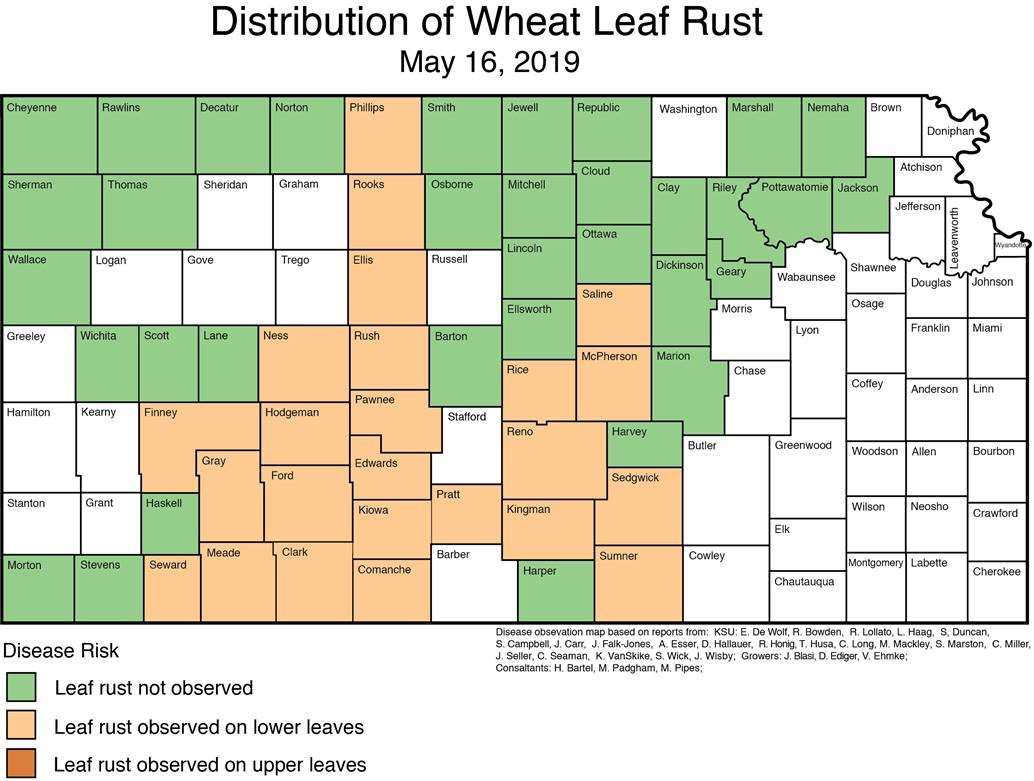
Here is the stripe rust map.
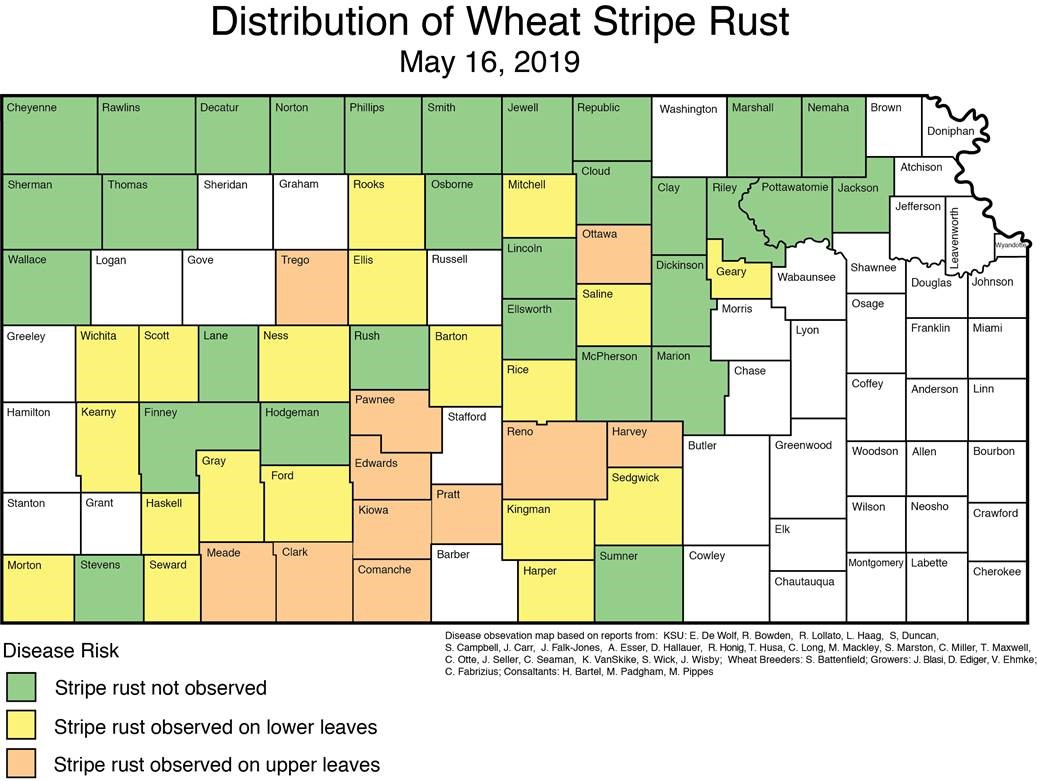
I visited with Erick DeWolf today to ask the likelihood of infections for our area. He commented that the weather (and the 10 day forecast) will be very influential on possible infections. Rust infections like wet and humid conditions…much like our weather last week. Here is a map from last Friday’s K-State Agronomy eUpdate to show the number of hours that were conducive to rust development last week:
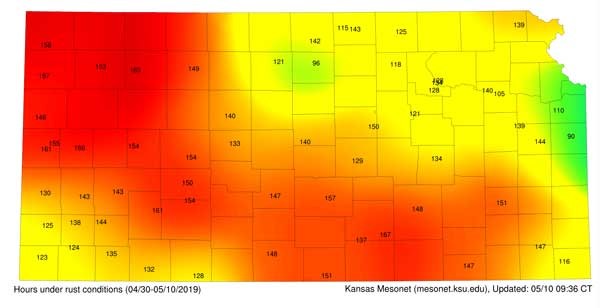
The numbers are a little difficult to make out, but I believe they read: Cheyenne – 158, Sherman – 157, Wallace – 145, and Colby – 153. The other influential factor is the temperatures. Overnight temperatures above 60 degrees slows the development of stripe rust. In south central Kansas, the overnight lows have been/will be above 60 this week. However, that is not the case in our area.
I also looked back over my notes and articles from prior years to help better understand the timeline for rust infection and the appearance of pustules. In general, it takes around 2 weeks for pustules to appear after the initial infection by the rust spore. However, that can stretch to 3 weeks from infection to pustule with less conducive weather. So, in theory, we could already have infection by rust spores, but the pustules have not yet developed.
At times, the yellow flecking on leaves has been attributed to being a precursor to the rust pustule. However, many environmental factors can cause physiological flecking. So, please don’t just assume flecking means stripe rust or leaf rust. We have had quite a bit of temperature swings and other environmental stress on our wheat in the last two weeks, so the flecking could be caused by this. Here is a picture of wheat that has physiological flecking on the leaf (this is a pretty severe case and was back lit to better show the flecking).
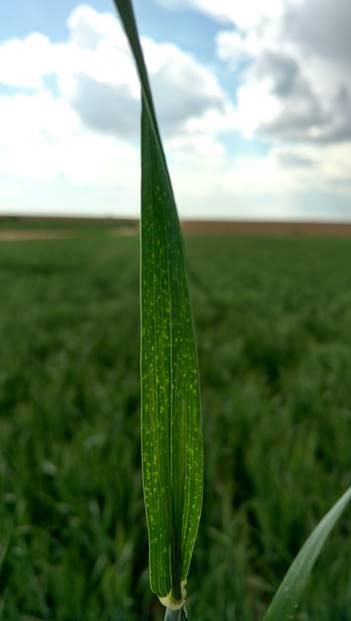
Figure 1. Physiological flecking on the wheat leaf. Photo by Jeanne Falk Jones.
So, all in all, we are in a period of waiting to see if stripe rust or leaf rust pustules appear. I think it is very important to remain vigilant in scouting for the rust diseases. I will continue to look through the wheat plots and let you know what I find. Just so everyone knows what we are looking for, here is an example of what the stripe rust pustules look like:
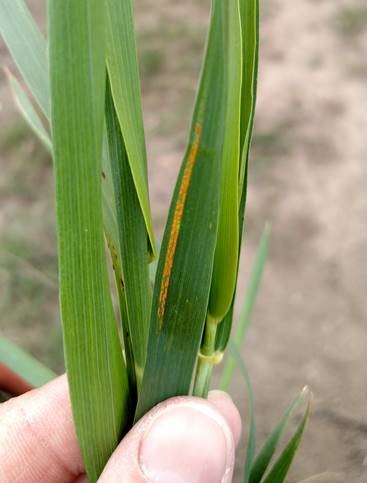
Figure 2. Stripe rust infection on wheat leaf. Photo by Jeanne Falk Jones.
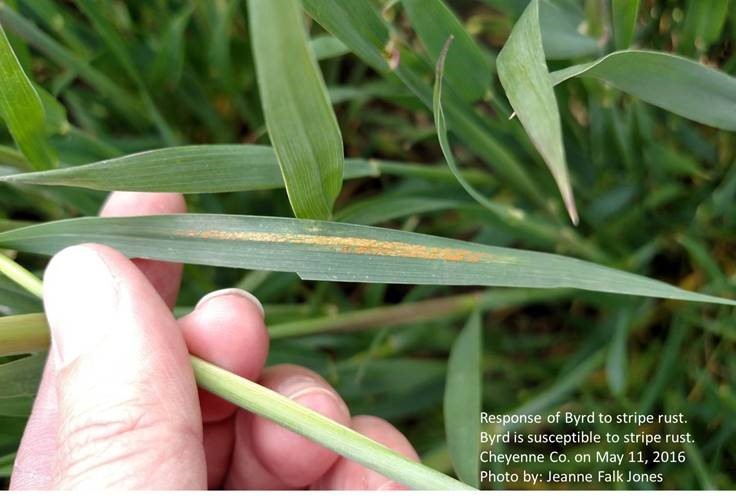
Leaf rust will be small round darker orange pustules, that occur randomly on the leaf surface (not in a stripe formation). Here is the publication from K-State on identifying rust diseases in wheat (it is also attached at the top of the page): https://www.bookstore.ksre.ksu.edu/pubs/MF2919.pdf
Remember, if it is difficult to tell what you have roll the leaf over your finger, while using the sky as a back drop. You are looking to see if there is a raised area where the pustule is located (raised area is from the spores being formed under the leaf cuticle). There may also be orange (the spores) that rubs off on your finger (although this is harder to see early in the infection period).
If you have any questions on rusts in wheat, please let me know! Also, if you find leaf rust or stripe rust (or something you are unsure about), grab a picture and a wheat sample. Send it to me or drop the sample off at the Extension office and we will get it identified! I think it is important to stay on the look out for stripe rust and leaf rust. We don’t need to check every day, but probably need to do a quick check every 2-3 days. And I will be sure to keep you updated on what I am finding in the wheat field.
It is that time, when we start discussing rust reports in wheat. There have been reports of both stripe rust and leaf rust in south central Kansas last week and this week. For both leaf rust and stripe rust in wheat, we listen to the south for rust reports. This is because rust spores move north on the wind. Therefore, I listen for reports in the panhandle of Texas and Oklahoma and southwest Kansas.
First, let's discuss the reports from Kansas. Leaf rust and stripe rust were found in low incidence last week in south-central Kansas by a UDSA plant pathologist and wheat breeder as they were checking research plots in Reno County. Yesterday, leaf rust reports came in for Finney (Garden City), Gray (Cimarron), Ford (Dodge City), Hodgeman (Jetmore), and Edwards (Kinsley) Counties. So far, it appears to be leaf rust that is most active but stripe rust is also present. The disease is still at low levels and restricted to the low and mid canopy. Wheat in these areas of the state is jointing but will be at flag leaf emergence soon. Some early fields may already be at flag leaf emergence. (Report from Erick DeWolf, K-State Wheat Pathologist)
Here is the current map for leaf rust infections in Kansas. This map was released yesterday afternoon.
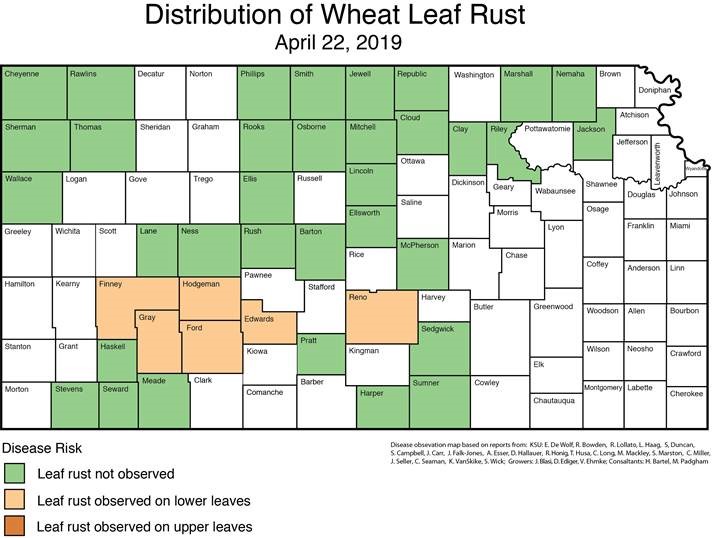
The rust diseases were found in varieties of wheat that are known to be susceptible. This means there is no evidence of changes in the populations of rust fungi to date. The disease was located in mid-canopy and still at low incidences (less than 1%).
I have been out in the field and have not found leaf rust or stripe rust in any wheat I have looked at. I will continue to scout for these diseases. If you see something you are concerned about or think you see rust, please let me know.
For Texas, the latest report that I have is from a wheat nursery in Castroville, just west of San Antonio. The plant pathologist said there was uniform infections of leaf rust on susceptible wheat varieties. In addition, stripe rust was present on susceptible varieties, but was drying up because of weather conditions. This report didn't contain any information on area west of that location, so I haven't heard a great deal on what they are seeing in western Texas.
For Oklahoma, we received a report last Friday. This report was from the plant pathologist at Oklahoma State University. He reported rust beginning to increase in severity in southwest Oklahoma. This is primarily leaf rust that is being reported and it is quickly approaching a time for the growers in southwest Oklahoma to make a decision about treating with a fungicide.
In addition, the incidence across the rest of the state of Oklahoma has been mixed, with some locations with no rust infections and other locations with very low incidence of leaf and stripe rust infections. However, given the present and short-term forecast for temperature and moisture, the Oklahoma State University pathologist expect leaf rust to increase. These conditions also are favorable for stripe rust, but the fact that it is being found in such low incidence, it indicates that the wheat may be more at risk from leaf rust than from stripe rust. (Report from Bob Hunger, OSU Plant Pathologist)
For northwest Kansas, there is no need for you to make management decisions based on these reports right now. The timing for fungicide applications is when there are flag leaves emerging and rust present on leaves just below the flag leaf. Mostly, I just want you to know what I am hearing about leaf rust and stripe rust infections to the south and east of our area.
I will keep you up to date on what I am hearing and seeing in the field, in relation to stripe rust and leaf rust. And if needed, we will discuss fungicide applications and wheat variety resistance. If you have any questions, please get ahold of me at the K-State Extension Offices in Sharon Springs, Goodland or St. Francis or on the K-State Experiment Station in Colby. You can see what I am finding in the field by following me on Facebook at K-State Sunflower District Agronomy.
